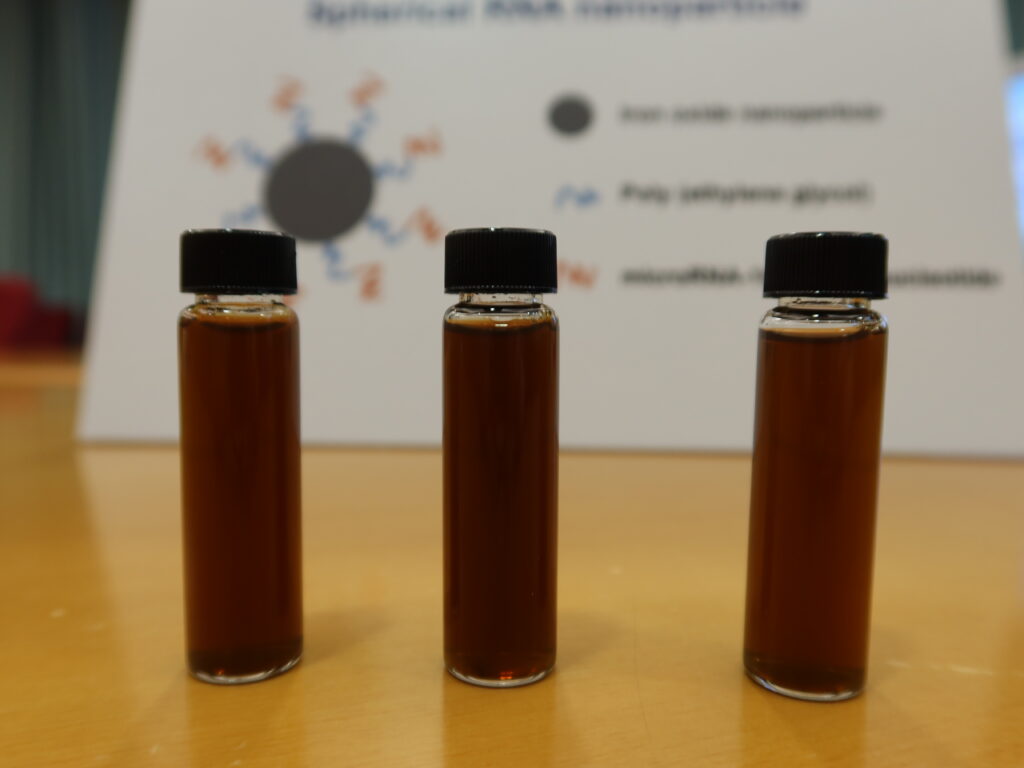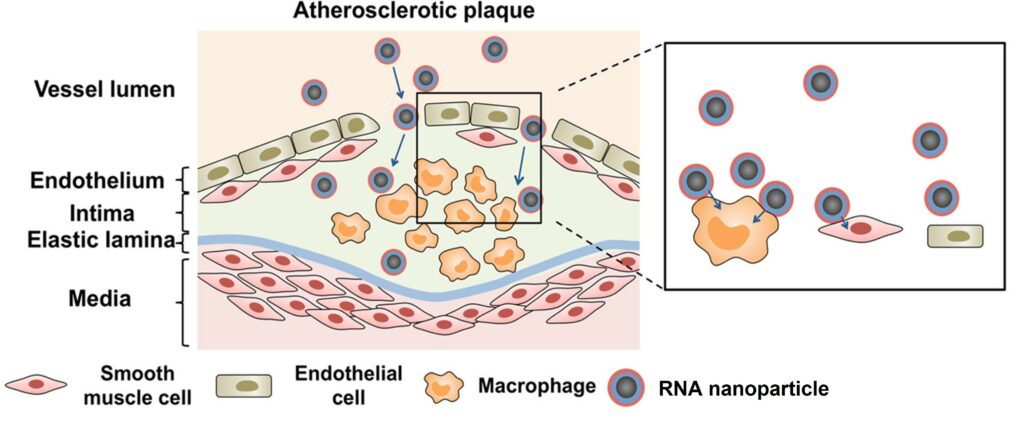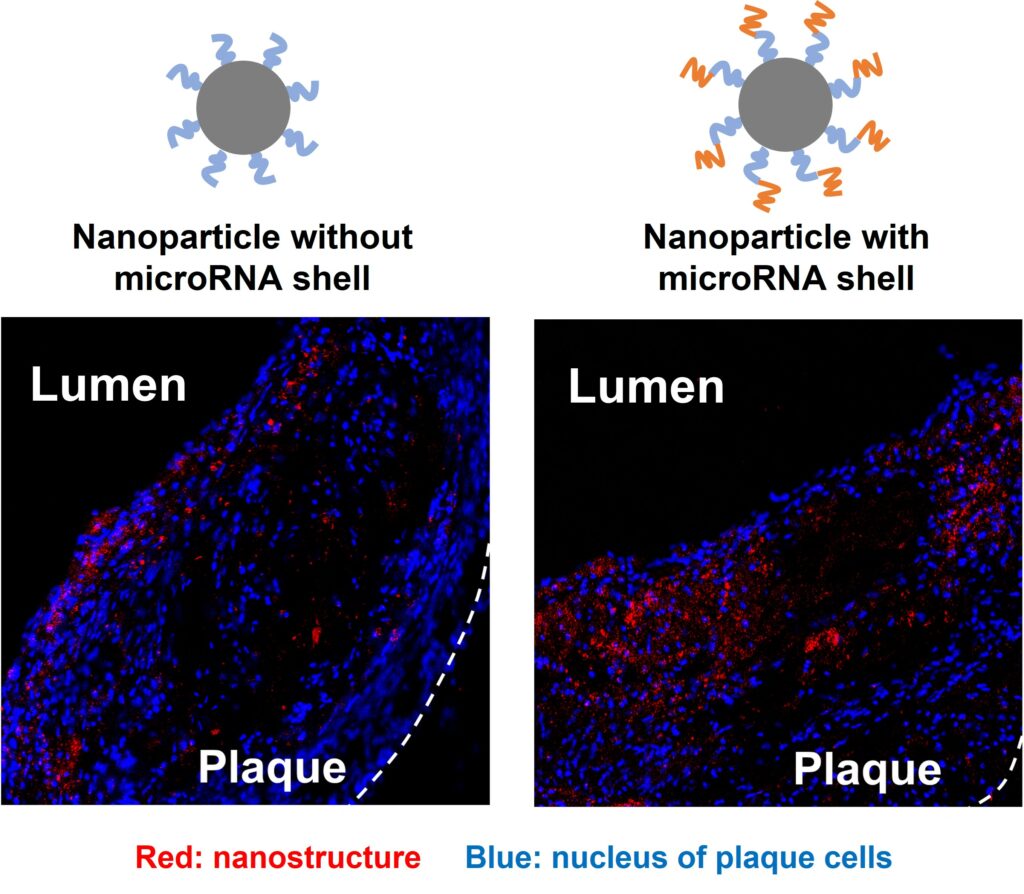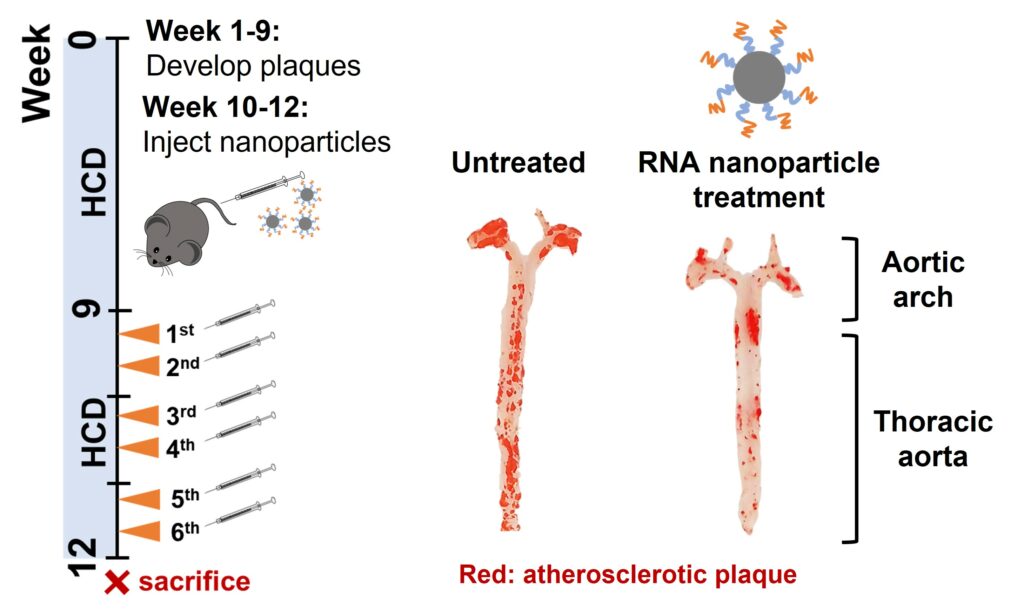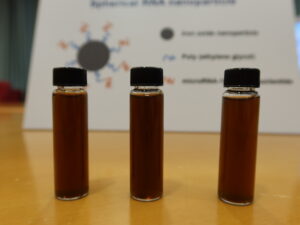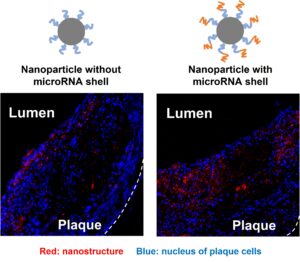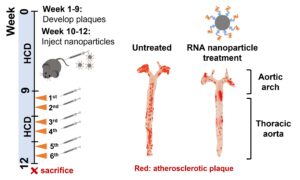CUHK
News Centre
CUHK researchers develop novel RNA nanoparticles for targeting and alleviating atherosclerotic plaque
The blockage of blood vessels caused by atherosclerosis is a major cause of stroke and ischemic heart disease. However, current treatments such as surgery are invasive, while lipid-lowering drugs can only slow down disease progression. Gene regulation is an emerging therapeutic approach to atherosclerosis, but delivery of therapeutic gene cargoes to atherosclerotic plaques is still inefficient. A team led by Professor Jonathan Choi Chung-hang, Associate Professor in the Faculty of Engineering’s Department of Biomedical Engineering at The Chinese University of Hong Kong (CUHK), has developed a novel RNA nanoparticle to offer a potentially safe, effective treatment for atherosclerosis.
Research has shown that this RNA nanoparticle can naturally target receptors of plaque cells for delivering genes to atherosclerotic plaques, while alleviating atherosclerosis by modulating genes related to atherogenesis, consequently reducing and stabilising plaque without inducing severe toxicity. It paves the way for the use of nucleic acid nanotechnology to treat cardiovascular diseases. This research, a collaboration with Professor Tian Xiao-yu, Assistant Professor in the Faculty of Medicine’s School of Biomedical Sciences at CUHK, has recently been published in the international journal The Proceedings of the National Academy of Sciences (PNAS).
Limitations of existing treatments
Atherosclerosis is a form of chronic inflammation, mainly induced by high levels of blood lipids. The buildup of fats, cholesterol and immune cells on the arterial wall will cause the formation of atherosclerotic plaques. Such plaques can either narrow the blood vessels to restrict the flow of blood or burst to form blood clots that block thinner arteries in the brain or heart, leading to stroke or ischemic heart disease. According to the World Health Organisation (WHO), stroke and ischemic heart disease accounted for 11% and 16% respectively of global mortality in 2020. In Hong Kong, heart disease has been the third-leading cause of death since the 1960s.
Existing treatments for atherosclerosis include surgical procedures such as balloon angioplasty and endarterectomy, but they are invasive and inefficient in reducing multiple plaque sites. Another treatment is administration of lipid-lowering drugs such as statins, but they can only slow down disease progression.
Bypassing the bottleneck for gene delivery with nucleic acid nanotechnology
Gene regulation is an emerging therapeutic approach to atherosclerosis, but current technology for gene delivery to plaque remains inefficient. Existing atherosclerosis nanomedicines mostly employ cationic carriers to complex gene cargoes through electrostatic interactions for gene delivery into plaque cells. Yet, these nanomedicines are often bulky, larger than 100 nm, meaning they can be rapidly filtered by the liver and spleen following an intravenous injection before they reach the plaque; and they are cationic which may induce cytotoxicity in the body.
Bypassing this bottleneck in gene delivery, Professor Choi’s team has applied nucleic acid nanotechnology to develop a new RNA nanoparticle for plaque delivery. This smaller spherical nanoparticle of about 70 nm in size includes a biocompatible iron oxide nanoparticle core, and about 300 therapeutic microRNA-146a strands attached to the core’s surface. It can naturally enter plaque cells without the aid of cationic transfection agents, thereby facilitating the intracellular delivery of microRNA-146a.
Data from the experiments have shown that upon an intravenous injection into mice that bear atherosclerotic plaques, the new RNA nanoparticle can naturally target the receptors on plaque cells and preferentially enter macrophages and endothelial cells inside the plaque. Dr Shirley Bai Qian-qian, first author of the publication and PhD graduate in the Faculty of Engineering’s Department of Biomedical Engineering, added, “The unique receptor-targeting property of the RNA nanoparticles contributes to their elevated plaque accumulation of up to 1.2% of the injected dose, one of the highest in the field of nanomedicine.”
Alleviating atherosclerosis with intravenous injections of RNA nanostructures
Furthermore, experiments have shown that repeated injections of RNA nanoparticles into plaque-bearing mouse models not only regressed and stabilised atherosclerotic plaque, but also downregulated genes related to immune response and vascular inflammation. After four weeks of treatment, there was no pronounced accumulation of RNA nanoparticle inside major internal organs, nor did it induce severe toxicity.
Professor Tian said, “The findings suggest that this RNA nanoparticle is a safe, effective agent to treat atherosclerosis, and it is now possible to design nucleic acid nanomedicines that are dual plaque targeting and therapeutic agents.”
Professor Choi added, “This study highlights the promise of nucleic acid nanotechnology to treat cardiovascular diseases. We hope to continue our collaboration with the CUHK Faculty of Medicine by validating the safety and efficacy of this RNA nanostructure in large animals. Ultimately, we hope to offer a safe, effective nanomedicine for patients with cardiovascular disease.”
The project was supported by the Research Grants Council of Hong Kong, the CUHK Vice-Chancellor Discretionary Fund, the CUHK Chow Yuk Ho Technology Centre for Innovative Medicine, the National Nature Science Foundation of China, and the Croucher Innovation Award from the Croucher Foundation.
The research paper can be found at https://www.pnas.org/doi/10.1073/pnas.2201443119.

(From left) Dr Shirley Bai Qian-qian, first author of the publication and PhD graduate in the Faculty of Engineering’s Department of Biomedical Engineering, and her two thesis supervisors: Professor Jonathan Choi Chung-hang, Associate Professor in the Faculty of Engineering’s Department of Biomedical Engineering, and Professor Tian Xiao-yu, Assistant Professor in the Faculty of Medicine’s School of Biomedical Sciences.
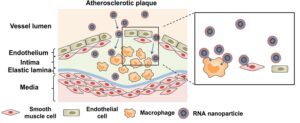
The spherical RNA nanoparticle contains a poly (ethylene glycol)-coated iron oxide nanoparticle inner core and an outer three-dimensional shell of microRNA-146a oligonucleotides. Upon intravenous injection, the RNA nanoparticle can accumulate in the atherosclerotic plaque and enter macrophages and endothelial cells inside the plaque.

